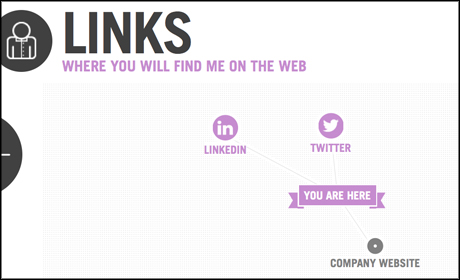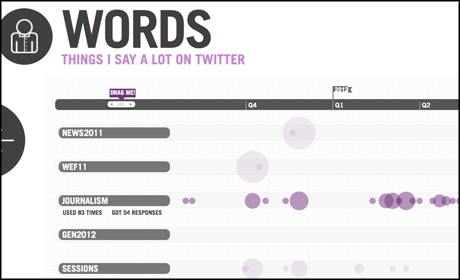
An example of a Vizify created from Twitter and LinkedIn sources
Online profile tool Vizify, which aims to act as a "tool for showing the best of you online", was launched last week, with plans to add tools writers, particularly freelancers, should find "really powerful".
Vizify looks at a person's activity across a number of selected social platforms, including Twitter, Facebook, LinkedIn and Foursquare, and the information they share.
This data is then used to produce a "graphical bio" on areas such as career progression, topics most involved in on social media, key comments and education.
As well as providing a platform for users to bring together their professional and social profile, such as for the eyes of potential employers, there is also the ability to produce a network of links to company websites or, in the case of journalists, published work.
The platform was co-founded by Todd Silverstein, who began his career as an editor for HarperCollins.
He told Journalism.co.uk that in its current form Vizify is "a great way of representing who you are and your personal brand".
"I shy away a little bit from that because it seems so marketing heavy, but one of the things we really are dedicated to, as you'll see in the product, is focusing on people and really helping them to make a strong and powerful and really attractive composite first impression."
Journalists can therefore already use the platform to "establish this is who I am, these are my bona fides, this is what I'm all about". But there are developments on the way which will make the platform even more useful for writers, he added.
"We have some exciting things in store that I'm a little bit reluctant to talk too much about, but specifically that I think writers and particularly practising freelancers will find really powerful as tools for showcasing some of their best work."
Journalists can already add links to collections of their work, such as blogs, web pages curating their journalism or individual articles.

"It's certainly a workable solution especially if there are a couple of pieces you want to highlight," Silverstein said. But he suggested that this is another area for possible development.
"We think there are more opportunities to bring some of those best pieces even more front-and-centre in the future, but for now it's one of the main reasons that we had that links page.
"Lots of people have blogs and other locations on the web they write at regularly and we wanted to make sure they could link to that".
He also added that he sees "a lot of fertile ground" in text visualisation. The site already offers a words page which analyses the words being tweeted most frequently across a timeline to "show how their use waxes and wanes in time".

"You can imagine moving forward not just having a mere portfolio but one of the things that we pride ourselves on is attempting to add a visual and additive component to the expression of such work, so that's something I'm really excited about," he added.
Since the platform's inception Silverstein had in mind the idea of a profile platform which could help the writing community.
"We've always been talking about from the very beginning, simply just because it's a group that's near and dear to my heart, as to how what we're working on can actually help journalists."
He said during its beta testing around 50 to 100 people who are "involved in publishing in one way, shape or form" helped by offering insight into how they look for work in today's market and "the sorts of things they typically get asked for when they're doing pitches". And his own experience in the publishing industry also came into play.
"It's still the quality of strength in your writing that's going to matter the most, but one of the things that I even learned in my publishing days is the most attractively packaged proposals tended to get a little more attention and be read first. The ones that came in the shiny boxes or had something attached to them.
"So human beings being what they are, I think when you're out there working and looking for work and it's a more competitive writers market than ever before, that really tight and effective self-presentation I think can actually help quite a bit."
The platform can be broken down in individual sections, represented on the main page by a clickable bubble, with one connected to the next.
Sections include a quote page, which pulls out "one of the most popular things that you've said by looking at retweets, or mentions or other things in the metadata".
There is also a photo page, which also pulls out key images based on 'likes' or tagging. He added that these pages are "flexible" and allow for human editing.
This means journalists or photographers can choose to showcase a handful of their own images instead, as part of the site's aim to offer a platform to display "the best of you online".
Free daily newsletter
If you like our news and feature articles, you can sign up to receive our free daily (Mon-Fri) email newsletter (mobile friendly).
Related articles
- Journalists are happy to be disconnecting from platforms, should news organisations be worried?
- Protecting journalists on social media, with Valérie Bélair-Gagnon
- What will your audience want in the future?
- 15 free sources of data on the media industry
- OMG is it that time again? The tax troubles of a freelancer









